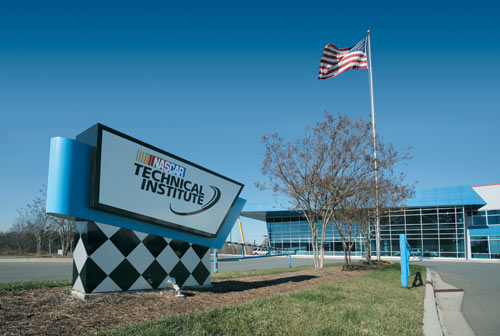NASCAR Technical Institute Relies on Lincoln

Eclipsing its status as the fastest growing sport in the United States, NASCAR® has become one of the nation’s largest businesses, boasting more than $3 billion in annual revenue.
NASCAR® racing as a sport has developed into an entertainment and marketing giant with a supporting culture that extends its southern roots well into America’s mainstream. But now, with some 40 top-level multi-driver racing teams competing 10 months a year, NASCAR® can no longer rely on local tradesmen and friends of the pit crew to staff the massive workforce needed to drive the industry.

Upon graduation, some students who are qualified and interested in pursuing a career with a high-end manufacturer, such as BMW or Jaguar, are given the opportunity to enter a training program sponsored by the manufacturer.
Students travel from all over the country to live in temporary housing in and around Mooresville for about a year. They learn from the best, said the school’s Community/NASCAR® Team Director, John Dodson, a 23-year racing veteran, who helped Richard Petty and Rusty Wallace capture dozens of victories.
“There is no other place like this,” he said. “Our relationships with NASCAR® teams help us place the top students all the time. But more often, it’s the race teams calling us for help.”

Upon graduation, some students who are qualified and interested in pursuing a career with a high-end manufacturer, such as BMW or Jaguar, are given the opportunity to enter a training program sponsored by the manufacturer.
Students travel from all over the country to live in temporary housing in and around Mooresville for about a year. They learn from the best, said the school’s Community/NASCAR® Team Director, John Dodson, a 23-year racing veteran, who helped Richard Petty and Rusty Wallace capture dozens of victories.
“There is no other place like this,” he said. “Our relationships with NASCAR® teams help us place the top students all the time. But more often, it’s the race teams calling us for help.”

Installed Lincoln® welding and cutting equipment includes several compact MIG welders, Precision TIG® TIG welders, Power MIG® MIG welders for thicker material and a Pro-Cut® plasma cutter for fast cuts on any conductive material.
The institute offers hands-on welding instruction for TIG and MIG welding. Students learn the metallurgical properties of various materials in respect to welding, including steel, aluminum and titanium. They study the importance of proper weld penetration and deposition and the effects of weld integrity in a racecar traveling 200 miles per hour.
“Students have to know that if a part is broken, it cannot break at the weld,” Dodson said. “They need to understand the importance of a sound weld, and that a driver’s life is on the line.”
Building racecars for NASCAR® is one of the most involved aspects of the sport. Each car can cost $175,000, much of which is paid to in-house welding labor. As the technology embedded in the cars becomes more complex, in the form of increasingly lighter, stronger, more exotic materials, the need for well-trained welders grows exponentially.

“These stations go all day long, so we wanted to be sure we were properly handling welding fume. We wanted a comprehensive welding solution, including arc welding equipment, fume control, and dedicated welding booths,” he said. “We chose the same welding equipment that most of the better NASCAR® teams use, and it’s easy to learn on, too. That’s a big advantage in a learning environment.”
Dodson said that using easily maneuverable low-vacuum fume extraction arms for every weld is as engrained into a student’s safety protocol as a helmet.
“Setting up the fume extraction system is just something every student must do before getting started,” he said.
Zac Teuscher knows that well. He graduated from the NASCAR® Institute in the spring of 2005 and considered environmental safety a major issue when choosing a school.
“
“I learned so much from my whole experience, and the Lincoln® school was a big part of that,” he said.
Teuscher now is a full-time welder for Thore Racing, a Craftsman® Truck Series team based in Sandusky, Ohio, not far from his hometown. He said the team is building a new state-of-the-art facility that will include environmental welding fume vacuum systems like the ones he used at NTI.
While the NTI school was developed to supply badly needed help for NASCAR®, most graduates head back home in search of high-paying dealership jobs. But it’s not a bad consolation, Dodson noted. For many students, a hometown job is their goal, and most students find themselves in a good position to achieve that.
For Teuscher, he considers himself luckier than most. He found a job in racing and close to home.
“It’s the best of both worlds,” he said. “But I think, had the NASCAR® Technical Institute not been there, I’d probably still be living at home wondering what to do with myself.”
